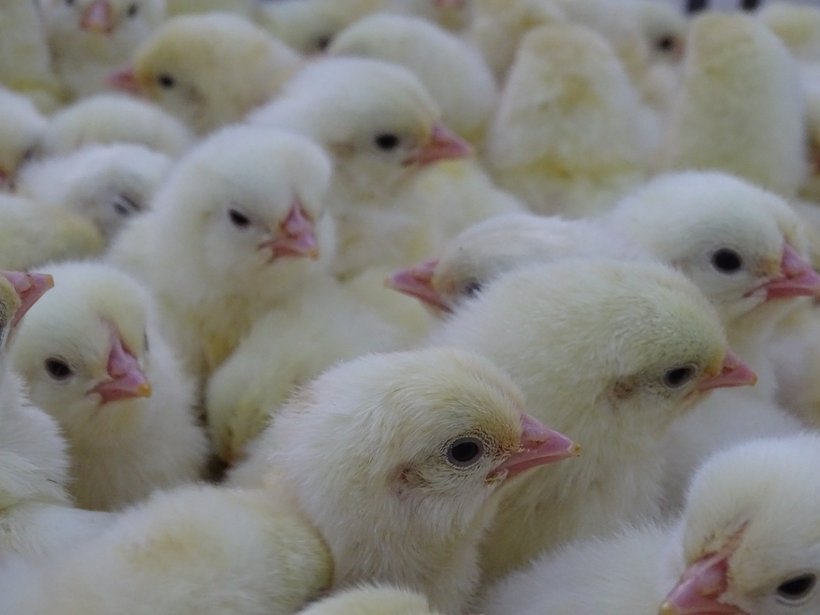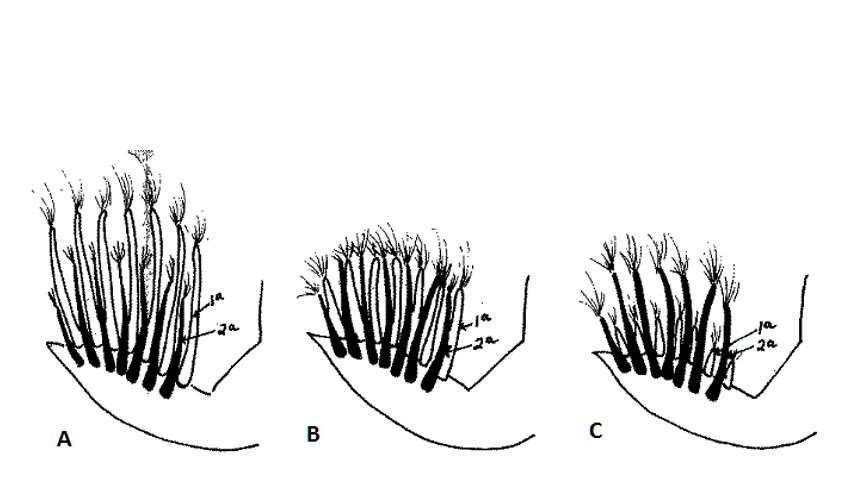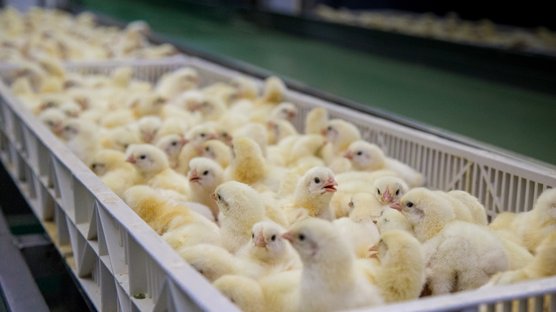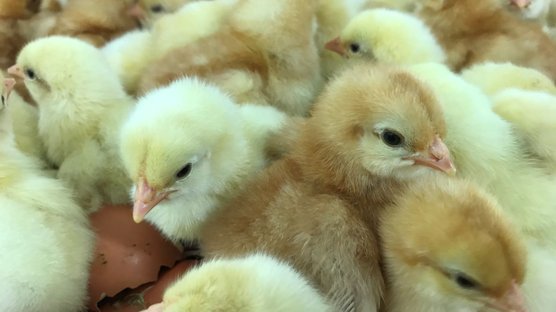
Published on Nov. 9, 2020
How to feather sex a chicken?
All commercial white hybrid egg layers marketed under the Babcock, Bovans, Dekalb, Hisex, ISA, Warren, and Shaver brands can be sexed at day-old using feather sexing. This technique is also applicable to several brown and black laying hen breeds, depending on the hybrid. In white egg layers, day-old female chicks are fast feathering, while day-old male chicks are slow feathering. But what exactly does that mean? In fast-feathering chicks, the primary wing feathers are noticeably longer and thicker than the covert feathers. In contrast, slow-feathering chicks have primary and covert feathers that are roughly the same length and thickness, making this method a simple and effective way to determine sex at hatch.
How to feather sex a chicken? Feather Sexing chicks in Practice
Sexing of day-old chicks can be done through several techniques: 1) color sexing, 2) vent sexing, 3) feather sexing, or 4) head spot sexing. While vent sexing can be used on any chick, the other methods are limited to specific breeds or genetic crosses. Each technique comes with its own set of challenges, which is why proper training is crucial to ensure accuracy and reduce sexing errors.
In this article, we focus on feather sexing chicks, explaining the background and genetic principles behind the method. Feather sexing relies on visible differences in feather development between male and female day-old chicks. If you're wondering how to feather sex a chicken, the answer lies in observing the length and structure of the wing feathers. In fast-feathering chicks (typically females), the primary wing feathers are longer and more pronounced than the covert feathers. In slow-feathering chicks (typically males), both types of feathers are about the same length and thickness.
It's important to note that feathering speed is genetically determined. Not all chicken breeds have been selected for feather sexing, so this method is not universally applicable. In commercial brown egg layers, color sexing is more commonly used. Many brown hybrids are either fully homozygous for fast feathering or heterozygous (containing both fast and slow feathering genes), making feather sexing ineffective. On the other hand, white egg layers—where color sexing isn’t possible due to the uniform yellow fluff of both sexes—have been genetically selected over time to allow reliable feather sexing of day-old chicks, offering a cost-effective solution for hatcheries.
The Benefits of Feather Sexing
Identifying the sex of day-old chicks by observing feather length—commonly known as feather sexing—offers several advantages over traditional vent sexing methods:
- No need for highly specialized personnel: While vent sexing must be done by experienced and specially trained staff, feather sexing chicks can be performed by personnel with minimal or no training, making the process more accessible and cost-efficient.
- Lower risk of infection: Vent sexing involves physical manipulation, which can introduce pathogens like Escherichia coli. Feather sexing eliminates this risk, as the chicks are not handled internally.
- Reduced error rate: For breeding purposes, especially when selecting female chicks, feather sexing reduces the chances of accidentally including males.
- Faster processing: Feather sexing chicks is significantly faster than vent sexing. This allows hatcheries to process and dispatch more chicks per hour, improving overall efficiency.
- Lower operational costs: Because feather sexing requires less training, fewer staff, and less time per chick, the overall cost of sexing is considerably reduced.
For those learning how to feather sex a chicken, the technique is simple, fast, and well-suited to large-scale hatchery operations—especially in white egg layer breeds where color sexing is not viable.
Disadvantages of Feather Sexing chicks
Feather sexing can only be performed on chicks resulting from the mating of fast normal-feathering males with slow-delayed-feathering females. In contrast, vent sexing can be applied to chicks of any breed. This means feather sexing chicks is limited to specific crosses where the feathering traits are genetically controlled and maintained.
Additionally, developing new breeds or lines that are suitable for feather sexing requires significant prior genetic work. This level of breeding management and control is often beyond the resources of most poultry farmers, limiting the widespread adoption of feather sexing in some operations.
The Genetic Basis of Feather Sexing: The K Gene
The difference between fast and slow feathering in chicks is controlled by the K gene, which governs feather development. This gene is located on the Z chromosome (female chickens have ZW chromosomes, while males have ZZ). By leveraging the K gene, breeders can produce distinct feathering patterns that help identify the sex of day-old chicks.
Through controlled mating and selective breeding, the K gene has been incorporated into white egg layer breeds, such as the Leghorns. In genetic lines where sex-linked delayed feathering (slow feathering) was initially absent, specialized breeding programs were used to introduce the K gene.
In commercial feather sexing, slow-feathered female parent breeders are mated with fast-feathered male parent breeders. This results in female chicks (commercial laying hens) exhibiting fast feathering, while male chicks (cockerels) show slow feathering. This clear feather difference allows hatcheries to accurately and efficiently identify the sex of day-old chicks using feather sexing techniques.
The Principle
When fast-feathered (k⁺k⁺) roosters are mated with slow-feathered (K) hens, the sex of their day-old chicks can be easily identified by feather length at hatch. Female chicks inherit one Z chromosome and will be fast-feathered (k⁺), while male chicks, with two Z chromosomes, will be slow-feathered (Kk⁺). This clear difference in feathering allows for straightforward feather sexing of chicks.
At the genetic level, the K locus has four known alleles with the following dominance hierarchy: Kn > Ks > K > k⁺. This genetic framework underpins the sex-linked feathering patterns used in commercial poultry breeding to separate males from females at hatch efficiently.
| Genotype | Phenotype |
|---|---|
| k+ or k+k+ | Fast feathering |
| K or KK | Slow feathering |
| Kk+ | Slow feathering males (K s is dominant over k+) |
.
k+ (fast-feathering)
The k⁺ allele is the most recessive in the feathering gene series. Day-old chicks homozygous for this allele (pure k⁺) display primary wing feathers (remiges) that are noticeably longer than the coverts (see Figure 1A). These fast-feathered chicks complete their feather development much more rapidly compared to their slow-feathered counterparts. The differences in feather growth and cover between fast and slow feathered chicks remain visible throughout the entire rearing period, making feather sexing an effective and reliable method for early sex identification.
K/Ks (delayed/slow feathering)
The K allele is a dominant variant in the feather growth gene series that controls the rate of feather development. In one-day-old chicks carrying this allele, the primary wing feathers (remiges) and coverts are of similar length (see Figure 1B). These slow-feathered chicks experience a delayed feather growth rate compared to fast-feathered birds, with the delay being most noticeable during the first few weeks of juvenile development and potentially lasting through the entire rearing period. Importantly, this delayed feathering does not affect the adult plumage. Sex-linked delayed feathering, controlled by the K allele, is commonly found in the female lines of white egg-producing leghorns and several broiler breeds.
Kn (ultra-slow/ very slow/ delayed or super slow-feathering gene)
The Kn allele, also known as the "naked" gene, is the most dominant variant in the feather growth gene series and has a dramatic impact on feather development. Birds carrying the Kn allele exhibit an extreme delay in feather growth, often appearing almost completely naked throughout their juvenile stage. In some cases, females carrying this gene may remain nearly naked even as adults. Day-old chicks with the Kn allele lack both primary and secondary remiges entirely, often showing only tiny pinfeathers. Additionally, birds with the Kn gene may display reduced comb size and slower overall growth. This ultra-slow feathering trait is also linked to a distinctive bald patch on the back of adolescent birds.

Figure 1. Feathering types Diagram of the wing of a one-day-old chick in dorsal view: A fast normal-feathering with the primary remiges (1a) longer than the coverlets (2a). B sex-linked delayed feathering with the primary remiges (1a) of the same length than the coverlets (2a). C modified delayed feathering with the primary remiges. (1a) shorter than the coverlets (2a).
source: Wikiwand
Take Home Message
Since the feathering status of the parent stock flock is critical for accurate feather sexing of day-old chicks, it is essential to regularly check for any sexing errors that may have slipped through at the hatchery. Whether it’s a male chick mistakenly identified as female or vice versa, these errors must be removed from the parent stock population immediately. Even a single sexing error in the parent flock can lead to numerous offspring where feather sexing becomes unreliable. This is particularly important for parent stock males, as they mate with many females and can quickly spread incorrect feathering traits. In white parent stock flocks, sexing errors are often detectable by examining the comb type: all Leghorn males with non-dubbed combs should be culled, as well as any parent stock females showing dubbed combs.
Ensuring strict quality control in the parent stock flock is essential for maintaining the accuracy of feather sexing chicks, which remains one of the most reliable and cost-effective methods for how to feather sex a chicken in commercial poultry production.
Feather sexing chicks is an essential, reliable method used in commercial poultry production for early and accurate identification of chick sex. Learning how to feather sex a chicken by examining feather length differences, determined by the K gene, allows hatcheries to efficiently separate males and females at day-old, reducing sexing errors and improving operational speed. The feather sexing method, while dependent on specific genetic crosses and careful management of parent stock, offers clear advantages over traditional vent sexing—including faster processing times, lower costs, and decreased risk of infection. By applying proper feather sexing techniques and maintaining strict quality control, poultry producers can enhance breeding accuracy, optimize flock management, and achieve better productivity in commercial egg-laying operations.



